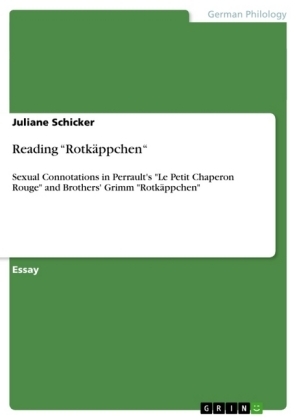
Reading "Rotkäppchen"
Sexual Connotations in Perrault's "Le Petit Chaperon Rouge" and Brothers' Grimm "Rotkäppchen"
Seiten
2009
|
2. Aufl.
GRIN Verlag
978-3-640-25936-6 (ISBN)
GRIN Verlag
978-3-640-25936-6 (ISBN)
- Titel ist leider vergriffen;
keine Neuauflage - Artikel merken
Essay from the year 2008 in the subject Didactics - German - Literature, Works, grade: 1,0 (A), Texas Tech Universität Lubbock, TX, USA (Texas Tech Universität Lubbock, TX, USA - Department of Classical & Modern Languages & Literatures, German Division), course: Romantik, language: English, abstract: The story of a little girl meeting a wolf while she brings her grandmother food is one of the most frequently adapted fairy tales of all time (Orenstein Uncloaked 6f.). In Germany, the girl is known as "Rotkäppchen", in English-speaking countries she is "Little Red Riding Hood", in France she is "Le petit chaperon rouge", and in Spain she is "Caperucita Roja". The general plot remains; however, various authors have adapted the way it is told to the social norms of their times. Two of the best known adaptations are the Brothers' Grimm Rotkäppchen and Charles Perrault's Le Petit Chaperon Rouge which were based upon the oral tale The Grandmother (Marshall 263). Both adaptations' contents and connotations have changed over time. The Brothers Grimm even published multiple versions of Rotkäppchen and modified it several times. The question needs to be asked why a story, which is shared by so many cultures, is told differently and changes in its content. The tale that is nowadays commonly known as a children's story started of as a tale of seduction (Orenstein Dances with Wolves). The audience was fully aware of the sexual connotations contained within The Grandmother. Perrault's tale was meant to amuse as well as to warn women about sexual advances. Rotkäppchen, however, lost most of its former sexual connotations, barely pointing to the obscenity contained within the original tale.This paper seeks to analyze one particular adaption in content: the loss of sexual connotations in Grimm's Rotkäppchen in comparison to Perrault's Le Petit Chaperon Rouge, which were both based upon the oral tale The Grandmother. The demonstration shows how the general views of society affect the content and the inferred meanings comprised within a tale. The Grandmother is introduced as the primary source of Perrault's Le Petit Chaperon Rouge, followed by a comparative analysis of Le Petit Chaperon Rouge and Grimm's Rotkäppchen. The tales will be examined in order to find out to what extent sexuality plays a role. Ideals and views of the times will be applied to the findings in order to argue that they are accountable for the decrease in sexual content.
| Sprache | englisch |
|---|---|
| Maße | 148 x 210 mm |
| Themenwelt | Schulbuch / Wörterbuch ► Lektüren / Interpretationen ► Deutsch |
| Schlagworte | BrothersGrimm • CaperucitaRoja • CharlesPerrault • Fairytale • GebrüderGrimm • innuendos • LePetitChaperonRouge • LittleRedRidingHood • Märchen • Märchenadaptionen • obscenity • Obszönität • Rotkäppchen • sexualconnotations • sexuelleKonnotationen • TheOldGrandmother |
| ISBN-10 | 3-640-25936-X / 364025936X |
| ISBN-13 | 978-3-640-25936-6 / 9783640259366 |
| Zustand | Neuware |
| Haben Sie eine Frage zum Produkt? |
Mehr entdecken
aus dem Bereich
aus dem Bereich
Buch | Softcover (2023)
Reclam, Philipp (Verlag)
7,40 €
Buch | Softcover (2022)
Reclam, Philipp (Verlag)
5,20 €


